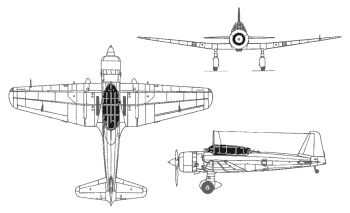



Yet another largely unsung Japanese aircraft of World War II, the Mitsubishi Ki-51 'Sonia' was something of a scaled down version fo the Ki-30 light bomber with the advantage of being able to operate from short airstrips close to the front lines. Given its smaller size and lighter weight, the Ki-51 dispensed with the weapons bay, carrying its reduced bomb load externally while a lower mounted wing allowed a shorter fixed undercarriage. The 'Sonia' made its combat debut in China as with many contemporary designs and was later deployed throughout the Pacific, performing admirably thanks to its maneuvrability, ease of maintenance, and short strip operation. Its service life continued up to the end of the war with production continuing well until 1944 although it was highly vulnerable to enemy fighters thus relegating it to secondary theaters and kamikaze strikes.
Two prototypes of the 'Sonia' were flown in June and August 1939 with a number of service trials aircraft following shortly after. The Ki-51 referred to the only production variant built although experimental aircraft were fitted with cameras in the rear cockpit for tactical reconnaissance duties while the similar Ki-71 prototype included a retractable undercarriage and uprated Ha-112 engines.
Preceded by:
NoneSucceeded by:
None | |
| Design | Ki-51 |
| Code Name | Sonia |
| Type | Close Support |
| Year | 1940 |
| Crew | 2 |
| Dimensions | |
| Length | 9.21 m |
| Height | 2.730 m |
| Wing Span | 12.10 m |
| Wing Area | n/a |
| Weight | |
| Empty | 1,873 kg |
| Maximum | 2,910 kg |
| Wing Loading | 121.1 kg/m² |
| Performance | |
| Speed | 423 km/h |
| Ceiling | 8,270 m |
| Range | 1,062 km |
| Powerplant | |
| Engine | 1 x Ha-16-II Mitsubishi 708 kW |
| Thrust/Weight | 0.46 |
| Armament | |
| Guns | 2 x 7.7/12.7-mm 1 x 7.7-mm |
| Payload | 200 kg |
| Production | |
| Built | 2,372 |
| Total | 2,385 |